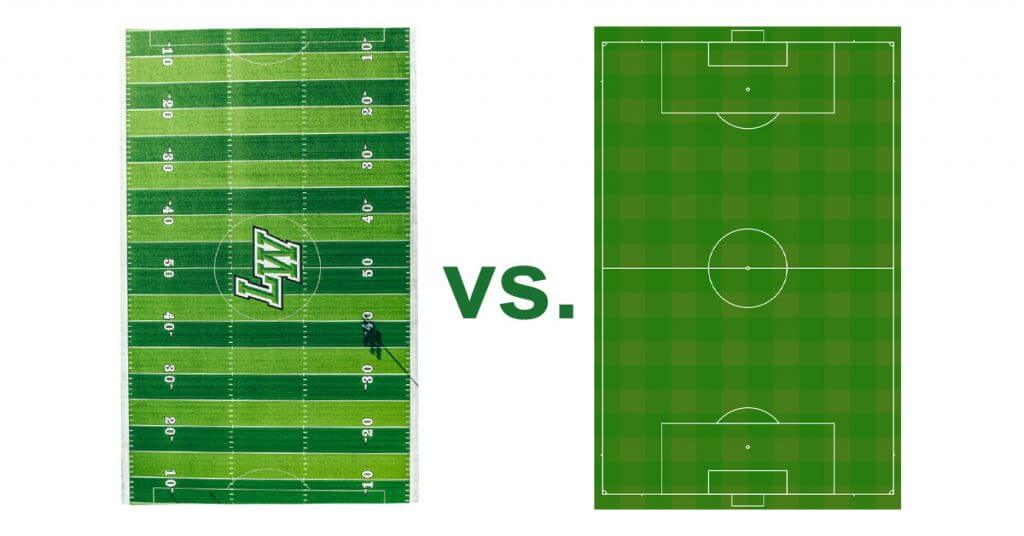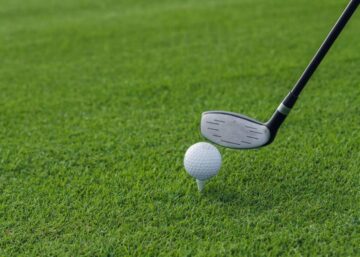Soccer and football are two of the most popular sports in the world. They have millions of fans and are played by both professionals and amateurs. One of the main differences between these two sports is the type of field they are played on. Soccer is played on a rectangular field, while football is played on a rectangular field with rounded corners.
The dimensions of the fields also differ between the two sports. A soccer field is typically larger than a football field, measuring between 100-130 yards in length and 50-100 yards in width. A football field, on the other hand, measures 120 yards in length and 53.3 yards in width. The lines on the field also differ, with soccer fields having a center circle and penalty areas, while football fields have a midfield line, end zones, and goal posts.
Field Dimensions
One of the most significant differences between soccer and football is the size of the playing field. While both sports are played on grass or artificial turf, the dimensions of the fields are quite different.
A standard soccer field is rectangular, with a length of 100-130 yards and a width of 50-100 yards. The field is divided into two halves, with a center circle in the middle. The goal posts are located at each end of the field, and they are 8 yards apart. The penalty box is located in front of each goal, and it is 44 yards wide and 18 yards deep. The goal area is a smaller box within the penalty area, and it is 20 yards wide and 6 yards deep.
A football field, on the other hand, is also rectangular, but it is much shorter and narrower than a soccer field. The standard football field is 100 yards long and 160 feet wide (53.3 yards). The field is divided into two halves, with a 50-yard line in the middle. The end zones are located at each end of the field, and they are 10 yards deep. The goal posts are located at the back of each end zone, and they are 18.5 feet apart.
It is important to note that the size of the field can vary depending on the level of play. For example, high school football fields may be smaller than college or professional fields. Similarly, soccer fields may be smaller for youth or indoor soccer.
Playing Surface
One of the most significant differences between soccer and football fields is the playing surface. While both sports are played on grass, the type of grass and maintenance requirements differ.
Soccer fields require a smoother and flatter surface, which is why they are often referred to as “pitches.” The grass is typically cut shorter and is more uniform in height. This allows for better ball control and smoother movement for players. Additionally, the grass is watered more frequently to keep it soft and prevent injuries.
Football fields, on the other hand, have a more rigid surface. The grass is cut slightly longer and is often mowed in a crisscross pattern to provide better traction for players. The grass is also watered less frequently to make it firmer and more durable for the heavy foot traffic and physical contact that occurs during football games.
Another difference between the two playing surfaces is the markings on the field. Soccer fields have markings for the center circle, penalty area, and corner kicks. Football fields have markings for the yard lines, hash marks, and end zones. These markings are essential for players to understand the boundaries of the game and the location of the ball.
Overall, while both soccer and football fields are made of grass, they have different maintenance requirements and playing surfaces. Understanding these differences is crucial for players to perform at their best and prevent injuries.
Goalposts and Nets
One of the most noticeable differences between a soccer field and a football field is the size and shape of the goalposts and nets.
In soccer, the goalposts are placed at the center of each goal line and are 8 yards apart. The posts are typically made of aluminum or steel and are 8 feet tall and 8 yards apart. The crossbar, which connects the two posts, is 8 feet off the ground. A net is attached to the back of the posts and the crossbar to catch any balls that pass through the goal.
In football, the goalposts are located at the back of each end zone and are 18 feet, 6 inches apart. The posts are made of aluminum or steel and are 10 feet tall. A crossbar connects the two posts and is 10 feet off the ground. Unlike soccer, football goalposts do not have nets attached to them.
The difference in the placement and size of the goalposts and nets affects the way the game is played. In soccer, the goalposts and nets are positioned in a way that requires the ball to be kicked into the goal. In football, the goalposts are located at the back of the end zone, which allows for a touchdown to be scored by carrying or throwing the ball into the end zone.
Overall, the differences in the size and placement of the goalposts and nets are just one of the many factors that make soccer and football unique sports.
Equipment
Both soccer and football require specific equipment to be played properly. However, the type of equipment needed for each sport differs significantly.
Soccer Equipment
For soccer, players need a ball, cleats, shin guards, and a uniform. The ball used in soccer is spherical and made of leather or synthetic materials. Cleats are shoes with protrusions on the sole that help players grip the ground and change direction quickly. Shin guards are worn under the socks to protect the player’s shins from kicks and collisions. The uniform consists of a jersey, shorts, and socks in matching colors.
Football Equipment
Football players require a helmet, shoulder pads, mouthguard, cleats, and a uniform. The helmet is designed to protect the player’s head from collisions and is made of hard plastic with foam padding on the inside. Shoulder pads are worn underneath the uniform to protect the player’s shoulders and chest. The mouthguard is a plastic device worn over the teeth to protect against dental injuries. The cleats are similar to those used in soccer, but with a different design to provide better traction on grass or turf.
Additionally, football players also use a ball that is oblong in shape and made of leather or synthetic materials. The ball is larger and heavier than a soccer ball, and has a pointed end that makes it easier to grip and throw.
| Equipment | Soccer | Football |
|---|---|---|
| Ball | Spherical | Oblong |
| Helmet | N/A | Required |
| Shoulder Pads | N/A | Required |
| Mouthguard | Optional | Required |
Overall, the equipment required for soccer is less extensive and less expensive than that required for football. However, the equipment needed for football is necessary to protect players from serious injuries that can occur during the game.
Rules and Regulations
Soccer and football are two different sports with their own set of rules and regulations. Here are some of the key differences:
Soccer Rules
- A soccer field is rectangular in shape and must be between 100-130 yards long and 50-100 yards wide.
- The game is played with 11 players on each team, including a goalkeeper.
- The objective of the game is to score more goals than the opposing team by getting the ball into the opposing team’s goal.
- Players are not allowed to touch the ball with their hands or arms (except for the goalkeeper within their designated penalty area).
- Players are not allowed to use excessive force or make dangerous tackles.
- A yellow card is given for minor offenses, while a red card is given for major offenses or two yellow cards.
Football Rules
- A football field is rectangular in shape and must be 100 yards long and 160 feet wide.
- The game is played with 11 players on each team, with separate players for offense, defense, and special teams.
- The objective of the game is to score more points than the opposing team by getting the ball into the opposing team’s end zone.
- Players are allowed to touch the ball with their hands or arms, but only the quarterback can throw the ball forward.
- Players are allowed to use force to tackle their opponents, but not excessive force or dangerous tackles.
- A yellow flag is thrown for minor penalties, while a red flag is thrown for major penalties or two yellow flags.
Overall, both soccer and football have their own unique set of rules and regulations that make them distinct from each other. Understanding these differences can help fans appreciate the nuances of each sport and enjoy them to the fullest.
Conclusion
After comparing and contrasting soccer field vs football fields, it is clear that both have their unique features and advantages. While soccer fields are larger and have fewer markings, football fields are smaller and have more markings. Soccer fields have a more uniform surface, while football fields have a more textured surface to provide better traction for players.
Another key difference between the two is the shape of the field. Soccer fields are rectangular, while football fields are more of a rectangle with two rounded edges. This difference in shape affects the way the game is played and the positioning of players on the field.
Ultimately, the choice between a soccer field and a football field depends on the sport being played and the preferences of the players and coaches. Both types of fields require maintenance and upkeep to ensure a safe and playable surface for athletes.







